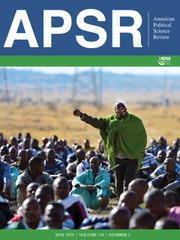The current team intends to broaden the range of work published at the Journal. To facilitate this, we now have five submission tracks available, each of which is designed for a distinctive type of contribution. We include a brief description of each track here, along with links to longer descriptions for those tracks that are especially novel. We look forward to your contributions!
-
• Regular Articles: original work to advance understanding of important issues.
-
• Research Notes: shorter, more focused articles.
-
• Registered Reports: submitted prior to any data analysis.
-
• Syntheses: summarize a field of research and usually include some empirical analysis.
-
• Replications and Reappraisals: revisit results previously published in the APSR or other journals.
Research Notes
The Research Notes track is designed for articles that are shorter and more focused than a Research Article. Submissions may be submitted initially as Research Notes or, during the review process—and by agreement of the handling editor and the corresponding author—reclassified as such.
Research Notes should aim to be 7,000 words or less (not including references or online appendices) on final publication. (Regrettably, we cannot reconsider submissions previously submitted and rejected.) We are introducing this track to encourage authors to submit papers that make a more focused contribution and to encourage reviewers to update their standards when assessing these papers.
Registered Reports
In a Registered Report track, the theory, methods, and proposed analyses are reviewed before the research is completed. If the design is considered promising enough, the Journal agrees to publish the paper so long as the ultimate implementation closely follows the design.
This format is a way of making research more reliable and interpretable by increasing the focus on excellent research design and reducing the degree to which authors, reviewers, and editors favor certain results. Because the review process typically takes place before the research design is finalized, it also allows authors to benefit from reviewer feedback at the design stage, which can produce more informative studies.Footnote 1
Syntheses
The Synthesis track is designed for articles that provide a synthetic view of a topic. These are not simply reviews of who said what; they are comprehensive attempts to grapple with an important research question and to push it forward. The goal is to foster knowledge cumulation.
To that end, a Synthesis should summarize the state of the field, identify strengths and weaknesses, track progress, and point the way toward productive avenues of future research. Authors should touch upon theory, methodology, and findings (though they may choose to focus on one of these aspects). Typically, they include some original data analysis. We welcome meta-analyses and “meta-models” (generalizing formal work that has appeared on a topic).
For the initial submission, we encourage (but do not require) authors to adopt a prospectus format. This allows the Journal to make an initial decision while saving the author time—an important consideration given the paucity of alternative outlets and given the coordination challenge posed by multiple submissions on the same topic.
Manuscripts may be submitted at any time. However, unlike other tracks at the Journal, initial submissions will be reviewed only once a year, in October. To be eligible for consideration, submissions should be complete by October 1. At publication, a Synthesis should be less than 11,000 words, not including references or online appendices (a soft target).Footnote 2
Replications and Reappraisals
Replications and Reappraisals reevaluate works published in the APSR or influential works published in other journals. Submissions can show mistakes in published work, reanalyze existing data with improved methods, or bring new data to bear on the same question. They can interrogate quantitative or qualitative work, formal theory, or political theory. They can critique the conclusions of the original article or support them. The primary criterion in assessing whether a replication/reappraisal should be published is whether it substantively enhances our understanding of the subject. While we don’t have a word limit for articles under this track, we encourage the authors to be concise and to the point; most such articles require less than 6,000 words.
Soon, we will also begin to solicit proposals for replication for a random set of articles published by the current editorial team in the APSR. We will select the most promising proposal and, once completed, have it reviewed along similar lines as a registered report. We believe this will address two issues in the current replication landscape: a bias towards negative findings and a bias towards replications of work on politically salient topics.Footnote 3


Comments
No Comments have been published for this article.